Function Words at the Interface: A Two-Tier Approach
Abstract
1. Introduction
- 1.
- ... schlag ə a Süpple vor wo bloß i =s Rezept kenn... suggest I.1sg.nom a soup.dim part, where only I.1sg.nom =det recipe know‘(For the beginning,) I suggest a soup of which only I know the recipe.’(Uderzo and Goscinny 2017, p. 26)
- 2.
- waisch du wo=(n-)ə des habknow.2sg.prs 2sg.nom where=(n-)1sg.nom this have.1sg.prs‘Do you know where I keep this?’
2. Function Words
2.1. The Phonological Representation of Function Words
2.2. Function Words at the Syntax–Prosody Interface
- 3.
- Lexical Category Condition (LCC): Constraints relating to syntactic and prosodic categories apply to lexical syntactic elements and their projections, but not to functional elements and their projections, or to empty syntactic elements and their projections. (Truckenbrodt 1999, p. 226)
- 4.
- [ verb [ fnc NP ] ]
- a.
- ( verb ( fnc ( NP ) ) )
- b.
- ( verb fnc ( NP ) )
- 5.
- match-phrase: Suppose there is a syntactic phrase (XP) in the syntactic representation that exhaustively dominates a set of one or more terminal nodes . Assign one violation mark if there is no phonological phrase () in the phonological representation that exhaustively dominates all, and only the phonological exponents of the terminal nodes in . (Elfner 2012, p. 134)
2.3. Function Words in p-structure
- 6.
- [ fnc [ lex ] ]
- a.
- as a prosodic word: ( ( fnc ) ( lex ) )
- b.
- as a free clitic: ( fnc ( lex ) )
- c.
- as an internal clitic: ( ( fnc lex ) )
- d.
- as an affixal clitic: ( ( fnc ( lex ) ) )
| 7. | a. | dɪ fraʊ vou -ʀ- ɪ aphʊL | |
| the woman who -ʀ- I pick.up | |||
| ‘The woman who I pick up.’ | |||
| b. | *dɪ fraʊ vou ɪ -ʀ- aphʊL | (Kabak and Schiering 2006, pp. 70–71) |
- 8.
- (((ˈfnc) fnc) (lex) )
- 9.
- ( (fnc-(ʀ)-fnc) (lex) )
- 10.
- ((fnc-(ʀ)-fnc) (lex))
- 11.
- (ˌne. ( ma. (ˈʃi:.nə)))
- 12.
- ((ˌne.ma.) (ˈʃi:.nə)) (Ito and Mester 2009, ex 34)
| 13. | a. | subcategorization frame for an enclitic: [ [ ... ] fnc ] |
| b. | subcategorization frame for a proclitic: [ fnc [ ... ] ] |
2.4. Pronouns as Function Words
- 14.
- (... ((pronoun)) (verb) )The pronoun is phrased as the head of a recursive -phrase,
- 15.
- (... (pronoun) (verb) )The verb receives the main accent, and the pronoun, a less prominent/optional accent.
2.5. Research Questions and Predictions
- (a)
- Is a distinction between function words and content words justified during the mapping at the syntax–prosody interface? Are there alternatives that can account for the variation found especially in the group of function words (as discussed in the previous sections)?
- (b)
- How are function words phrased with the preceding and following material at p-structure? Are there any phonological or prosodic indicators which point towards a particular prosodic structure?
3. Material and Methods
3.1. Asterix—Written Swabian
3.1.1. Method
- (a)
- Position: initial, medial, or final;where ‘initial’, ‘medial’ and ‘final’ refer to the linear positions of the pronouns in a sentence.
- (b)
- Information structure status: focussed8 or unfocussed;as determined by syntactic structure, focus particles, or context.
3.1.2. Asterix—Results
- 16.
- I woes wia -n- ə dia Garnison ...I.1sg.nom know.1sg.prs how -n- I.1sg.nom that garrison ...‘I know how I (can convince) that garrison ....’
3.1.3. Asterix—Discussion
| 17. | a. | Dr wirkliche Häuptling ben i | |
| The real chief am I.1sg.nom | |||
| ‘I am the real chief!’ | (Uderzo and Goscinny 2017, p. 5) | ||
| b. | Glei platz ə | ||
| In.a.second explode I.1sg.nom | |||
| ‘I’ll explode in a second!’ | (Uderzo and Goscinny 2017, p. 16) |
- 18.
- Context: The faqir drank too much wine and has a hang-over as a consequenceHan i en Durscht!have.prs.1sg I.1sg.nom a.m.acc thirst‘I am (so) thirsty!’ (Uderzo and Goscinny 2017, p. 70)
- 19.
- Context: Obelix is being denied the magic potionWarom ausgrechnet i net?Why of.all.people I.1sg.nom not‘Why not me, of all people? ’ (Uderzo and Goscinny 2017, p. 27)
- 20
- Context: Impedimenta/Gutemine, the chief’s wife, and Mrs. Geriatrix/Methusalix are fighting over a carpet they found between their houses. When Impedimenta runs out of arguments as to why the carpet should belong to her, she yells:... ond außerdem ben i ’s Weib vom Chef!... and besides be.1sg.prs I.1sg.nom =the.n.nom wife of.the chief‘And besides, I am the chief’s wife!’
- 21.
- Context: During travelling, the faqir is wondering whether they are still on the right way, so he tells his companions that he will ask... ob =ə no uf am rechta Weg be... if I.1sg.nom still on the.m.dat right way be.1sg.prs‘.... if I am still on the right way.’
3.2. The Zwirner Corpus—Spoken Swabian
3.2.1. Method
3.2.2. Zwirner Corpus—Results
- 22.
- Context: The speaker tells the story of how he and a school friend had a competition as to who would dare to jump over a box.ja hã ə gsagt wenn du nom-schprengsch schpreng i au nomyes have I.1sg.nom say.ptcp if you over-jump jump I.1sg.nom also over‘ “Yes”, I said, “if you jump over (that), I’ll jump over (that), too!” ’(Zwirner Corpus 2012, Sp 175, 667 s)12
3.2.3. Zwirner Corpus—Discussion
- 23.
- (des) wois i nõ wieder net so(this) know.1sg.prs I.1sg.nom now in.turn neg so‘This, in turn, I don’t know so much about.’ (Zwirner Corpus 2012, Sp 96, 293 s)
- 24.
- ond des fend i oheimlich scheeand this find.1sg.prs I.1sg.nom incredibly nice‘And I find this incredibly nice.’ (Zwirner Corpus 2012, Sp 174, 223 s)
| 25. | a. | wo -n-i in dem Alder gwea ben | |
| when -n- I.1sg.nom at that age be.ptcp be.1sg.prs | |||
| ‘When I was at that age ...’ | |||
| (Zwirner Corpus 2012, Sp 96, 315 s) | |||
| b. | weil na wo -n- ə wieder | ||
| because then when -n- I.1sg.nom again | |||
| ‘Because when I again (had to work at home ...)’ | |||
| (Zwirner Corpus 2012, Sp 96, 857 s) |
4. The Prosodic Phrasing of Function Words: Evidence from n-Insertion
| 26. | a. | wo -n- =ə =ən17 seh |
| where -n- I.1sg.nom he.3sg.m.acc see.1sg.prs | ||
| ‘... where I see him.’ | ||
| b. | seh -n- =ə =ən | |
| see.1sg.prs -n- I.1sg.nom he.3sg.m.acc | ||
| ‘... I see him.’ | ||
| c. | *wo =ə -n- =ən seh | |
| where I.1sg.nom -n- he.3sg.m.acc see.1sg.prs | ||
| ‘... where I see him.’ | ||
| d. | *dass Kai -n- Ann sieht | |
| that Kai.3sg.f.nom -n- Ann.3sg.f.acc see.3sg.prs | ||
| ‘...that Kai sees Ann.’ |
5. Function Words at the Interface
- 27.
- subcategorization frame for an enclitic: [ [ ... ] fnc ]
| 28. | a. | I ((helf) =əm)! | (I-help-him, ‘I am going to help him!’) |
| b. | ((I) =han =əm) gholfa! | (I-have-him-helped, ‘I (alone) helped him!’) | |
| c. | ((I) =han =’s =əm) gsagt! | (I-have-it-him-told, ‘I (alone) told him that!’) |
5.1. A Two-Tier Approach to the Interface
| 29. | a. | Match-word: | Match every syntactic form with its phonological form |
| b. | Match-: | Match every phonological form with its syntactic form |
- 30.
- ... wo -n- ə sə gsea han... where -n- I.1sg.nom she.3sg.f.acc see.prtcp have.1sg.prs‘... where I have seen her. ’ Standard German: wo ich sie gesehen habe
5.2. The Prosodic Phrasing of Function Words: p-Structure
| 31. | a. | Interface: | ((( wo)) (=ə) ((=sə) ( gs‿ea)) =han) |
| b. | P-structure: | ((( wo) -n- =ə =sə)) ((( gs‿ea) =han))) |
- 32.
- C1: Following the strict layer hypothesis (a.o. Nespor and Vogel 1986; Selkirk 1995), -phrases cannot consist solely of a prosodically dependent clitic.
- 33.
- C2: Enclitics form a recursive prosodic word structure with the preceding prosodic word.
- 34.
- C3: Optionally insert -n- between two vowels at a minimal, non-maximal prosodic word boundary.
- 35.
- Input ∘ C1 ∘ C2 ∘ C3 ⇒ Output
| 36. | input: | wo= ) ( ( i ) ) (( =sə ) ( gsea ) ) =han ) |
| : | wo= ( ( i ) ) ( =sə ( gsea ) =han ) | |
| : | ( ( wo= ( i ) =sə ) ) ( ( ( gsea ) ) =han ) ) ) | |
| : | ( wo= -n- ( i ) =sə) ( ( gsea ) =han ) ) ) |
6. Conclusions
Funding
Institutional Review Board Statement
Informed Consent Statement
Data Availability Statement
Acknowledgments
Conflicts of Interest
| 1 | See Section 2 for a detailed discussion of these terms. |
| 2 | This paper assumes a modular, indirect view of the interface and grammar in general. Following Fodor (1983), modules are encapsulated systems with their own “vocabulary” and their own set of rules, principles, and constraints, and interfaces are restricted to exchange only information relevant to each module. It is further assumed that the prosodic structure is part of the phonological module (p-structure) and is hierarchically organised into different prosodic domains (a.o., Selkirk 1978): The intonational phrase (), the phonological phrase (), the prosodic word (), the foot (Ft), and the syllable (). |
| 3 | The form [ə] is usually represented by ‘e’ in written text. In order to avoid confusion, [ə] will be used throughout the paper. |
| 4 | Projections in LFG are typically abbreviated as ↑ with a subscript indicating which other module constrains the structure in the current module. For example, in a syntactic structure states that the present syntactic structure is constrained by the information associated with this (syntactic) part in i(nformation)-structure. This allows for certain syntactic structures to emerge or to be excluded based on the information found in i-structure. |
| 5 | Originally formulated within the Optimality Theory (OT; Prince and Smolensky 2004), Match constraints can easily be transferred into other constraint-based frameworks (for example, LFG, see Section 5.1). |
| 6 | Throughout the text, syntactic structures will be marked by square brackets, and prosodic structures by round brackets. |
| 7 | The collection used for this paper includes Asterix and the great divide and Asterix and the magic carpet. |
| 8 | Where focus here is defined as indicating ‘the presence of alternatives that are relevant for the interpretation of linguistic expressions’ (Krifka 2008, p. 247), see also Dipper et al. (2007); Rooth (2016). |
| 9 | This particular corpus was chosen because there are no other resources for unscripted spoken Swabian. That is, the speakers are not prompted to use a particular expression, but speak freely in their native dialect. Another advantage of the corpus is that the recordings reflect the “original” dialect without the now common influence through exposure to other dialects (including Standard German). |
| 10 | The speakers are from villages between Stuttgart and Ulm, mostly from the region “Alb-Donau-Kreis”. All of them grew up in this region as well. According to the Landeszentrale für politische Bildung (State headquarters for political education) in the state of Baden-Württemberg, these villages are in the Middle Swabian area; three of the speakers are relatively close to the boarder of the Eastern Swabian area: https://www.landeskunde-baden-wuerttemberg.de/dialekte-bw (accessed on 3 June 2021). With respect to the use of the two forms, no variation was found amongst the speakers. |
| 11 | Pronoun drop in Swabian can optionally occur if the pronoun is highly predictable and unstressed; that is, it is a p-structure internal process that can be applied to a weak pronoun. This adds to the discussion in Section 2.1 and the claim that frequency and/or predictability correlates with reduction (in this case deletion). As the focus of this paper is on the interface mapping and the distribution of the two forms, pronoun drops will not be discussed any further (see Haag-Merz 1996; Bohnacker 2013 for further information). |
| 12 | For the references to the corpus, the official speaker number (here: Sp 175) and the sentence’s position in the overall utterance in seconds (here: 667 s) is given. |
| 13 | Note that in Swabian, these auxiliaries can either be pronounced with a long nasal vowel, or with a reduced vowel followed by -n: han and kann. Caro Reina (2019, p. 276) reports that the final ‘n’ emerges only if a vowel-initial pronoun follows; otherwise ‘n’ is deleted and the auxiliary vowel is nasalized. This could not be unambiguously confirmed with the data at hand, but as this obvservation might potentially lead to a confusion of n-insertion with the auxiliary-final “n”, two criteria had to apply for an example to count as n-insertion: (a) The nasalized vowel had to be clearly audible and (b) the speaker had to use the nasalised version in other contexts. |
| 14 | Des had to be excluded from the signal as it overlaps with a question asked by the interviewer which results in a disturbance of the speech signal. |
| 15 | Note that the cited works are not concerned with function words but discuss content words. As the data from the corpus used in this paper are not carefully/experimentally controlled, an analysis of, for example, duration, has to be left for further research. |
| 16 | The literal translation for wo is where. However, in Swabian it is often used to express ‘when’ (Standard German als). This is the case in both of these examples. |
| 17 | [ən] is the reduced pronoun form for the third person singular masculine accusative pronoun; the strong form is [i:n]. |
| 18 | See (6) for a definition of the different types of clitics according to Selkirk (1995). This analysis does not automatically extend to all types of reduced function words, for example, articles (see Caro Reina 2019, p. 299, on interesting observations concerning the interaction of proclitic articles and glottal stop). |
| 19 | The claim that wo, like most monosyllabic, frequent function words, has a strong form and a weak form, is (informed) speculation. How these two forms are distinguished in terms of, for example, vowel quality and duration (which is visibly different in Figure 4a,b), needs to be established by further (carefully controlled) research. |
| 20 | As discussed in Section 2, the term “lexical” does not only refer to content words. Crucially, both function words and content words are part of the mental lexicon and are thus both described as “lexical elements”. |
| 21 | As Levelt et al. (1999) note, listing the segments independently of the syllables allows for them to be resyllabified to, for example, following words. |
| 22 | The foot structure is excluded from further illustrations to allow for a simpler representation of the data. |
| 23 | The encoding of prosodic status at the lexical level can easily be extended to cover the prosodic phrasing of, for example, compounds and other structures whose prosodic structure cannot be predicted by their syntactic representation. |
| 24 | See Section 1 for a brief introduction to the framework used in this paper. |
| 25 | |
| 26 | The same is true for several ‘connecting’ lines which abstractly represent associations/projections between the structures. |
| 27 | The choice of attributes or the basic organisation is up to the researcher and the research question. P-diagrams can, in principle, also be build on, for example, moras or segments. They can also be used to encode raw acoustic information from a speech signal or include information on pitch accents; see Bögel (2020a) for a more detailed example. |
| 28 | Phonological material and the various p-structure constraints are combined via the composition operator ∘ (see below in 35) and form a mathematically well-defined cascade (see Kaplan and Kay 1994 for details, Beesley and Karttunen 2003 for the applicability in computational linguistics). |
References
- Baumann, Stefan. 2006. The Intonation of Givenness. Number 508 in Linguistische Arbeiten. Tübingen: Niemeyer. [Google Scholar]
- Baumann, Stefan. 2016. Second occurrence focus. In The Oxford Handbook of Information Structure. Edited by Caroline Féry and Shinichiro Ishihara. Oxford: Oxford University Press, pp. 483–502. [Google Scholar]
- Baumann, Stefan, Johannes Becker, and Doris Mücke. 2010. Expression of second occurrence focus in German. Linguistische Berichte 221: 61–78. [Google Scholar]
- Baumann, Stefan, and Martine Grice. 2006. The intonation of accessibility. Journal of Pragmatics 38: 1636–57. [Google Scholar] [CrossRef]
- Beaver, David, Brady Zack Clark, Edward Flemming, T. Florian Jaeger, and Maria Wolters. 2007. When semantics meets phonetics: Acoustical studies of second-occurrence focus. Language 83: 245–76. [Google Scholar] [CrossRef]
- Beaver, David, and Dan Velleman. 2011. The communicative significance of primary and secondary accents. Lingua 121: 1671–92. [Google Scholar] [CrossRef]
- Beesley, Kenneth R., and Lauri Karttunen. 2003. Finite State Morphology. Stanford: CSLI Publications. [Google Scholar]
- Bell, Alan, Jason M. Brenier, Michelle Gregory, Cynthia Girand, and Dan Jurafsky. 2009. Predictability effects on durations of content and function words in conversational English. Journal of Memory and Language 60: 92–111. [Google Scholar] [CrossRef]
- Bennett, Ryan, Emily Elfner, and James McCloskey. 2016. Lightest to the right: And apparently anomalous displacement in Irish. Linguistic Inquiry 47: 169–234. [Google Scholar] [CrossRef]
- Bennett, Ryan, Emily Elfner, and James McCloskey. 2019. Prosody, focus, and ellipsis in Irish. Language 95: 66–106. [Google Scholar] [CrossRef]
- Boersma, Paul, and David Weenink. 2013. Praat: Doing Phonetics by Computer [Computer Program, Version 5.3.56]. Available online: http://www.praat.org/ (accessed on 15 September 2013).
- Bögel, Tina. 2020a. German case ambiguities at the interface: Production and comprehension. In Prosody in Syntactic Encoding. Edited by Gerrit Kentner and Joost Kremers. Number 573 in Linguistische Arbeiten. Berlin: De Gruyter, pp. 51–84. [Google Scholar]
- Bögel, Tina. 2020b. Rhythmic phrasing of prosodic words: A diachronic perspective from Old English, supported by experimental evidence from German. In Proceedings of the 50th Annual Meeting of the North Eastern Linguistic Society (NELS 50). Amherst: GLSA, vol. 1, pp. 59–72. [Google Scholar]
- Bohnacker, Ute. 2013. Null subjects in Swabian. Studia Linguistica 67: 257–89. [Google Scholar] [CrossRef]
- Boye, Kasper, and Roelien Bastiaanse. 2018. Grammatical versus lexical words in theory and aphasia: Integrating linguistics and neurolinguistics. Glossa: A Journal of General Linguistics 3: 29. [Google Scholar] [CrossRef]
- Bresnan, Joan, Ash Asudeh, Ida Toivonen, and Stephen Wechsler. 2016. Lexical-Functional Syntax, 2nd ed. Malden: Wiley-Blackwell. [Google Scholar]
- Bresnan, Joan, and Ronald M. Kaplan. 1982. Lexical-Functional Grammar: A formal system for grammatical representation. In The Mental Representation of Grammatical Relations. Edited by Joan Bresnan. Cambridge: MIT Press, pp. 173–281. [Google Scholar]
- Bresnan, Joan, and Sam Mchombo. 1995. The lexical integrity principle: Evidence from Bantu. Natural language and Linguistic Theory 13: 181–254. [Google Scholar] [CrossRef]
- Caro Reina, Javier. 2019. Central Catalan and Swabian. Berlin and Boston: De Gruyter. [Google Scholar]
- Chen, Matthew Y. 1987. The syntax of Xiamen tone sandhi. Phonology Yearbook 4: 109–49. [Google Scholar]
- Chomsky, Noam. 1965. Aspects of the Theory of Syntax. Cambridge: MIT Press. [Google Scholar]
- Cutler, Anne. 1993. Phonological cues to open- and closed-class words in the processing of spoken sentences. Journal of Psycholinguistic Research 22: 109–31. [Google Scholar]
- Cutler, Anne. 1996. Prosody and the word boundary problem. In Signal to Syntax: Bootstrapping from Speech to Grammar in Early Acquisition. Edited by James L. Morgan and Katherine Demuth. Mahwah: Lawrence Erlbaum, pp. 87–99. [Google Scholar]
- Cutler, Anne, and David M. Carter. 1987. The predominance of strong initial syllables in the English vocabulary. Computer Speech and Language 2: 133–42. [Google Scholar] [CrossRef]
- Dalrymple, Mary. 2001. Lexical Functional Grammar. San Diego: Academic Press. [Google Scholar]
- Dipper, Stefanie, Michael Goetze, and Stavros Skopeteas, eds. 2007. Information Structure in Cross-Linguistic Corpora: Annotation Guidelines for Phonology, Morphology, Syntax, Semantics and Information Structure, Volume 7 of Interdisciplinary Studies on Information Structure. Potsdam: Universitätsverlag Potsdam. [Google Scholar]
- Elfner, Emily. 2012. Syntax–Prosody Interactions in Irish. Ph.D. thesis, University of Massachusetts Amherst, Amherst, MA, USA. [Google Scholar]
- Elfner, Emily. 2015. Recursion in prosodic phrasing: Evidence from Connemara Irish. Natural Language and Linguistic Theory 33: 1169–208. [Google Scholar] [CrossRef]
- Féry, Caroline. 2020. Grammatical reflexes of information structure in Germanic languages. In Cambridge Handbook for Germanic Linguistics. Edited by Mike T. Putnam and B. Richard. Cambridge: Cambridge University Press, pp. 661–85. [Google Scholar]
- Féry, Caroline, and Frank Kügler. 2008. Pitch accent scaling on given, new and focused constituents in German. Journal of Phonetics 36: 680–703. [Google Scholar] [CrossRef]
- Féry, Caroline, and Shinichiro Ishihara. 2009. The phonology of second occurrence focus. Journal of Linguistics 45: 285–313. [Google Scholar] [CrossRef]
- Fodor, Jerry A. 1983. The Modularity of Mind. Cambridge: MIT Press. [Google Scholar]
- Fries, Charles Carpenter. 1940. American English Grammar. New York: Appleton-Century-Crofts. [Google Scholar]
- Ghini, Mirco. 1993. Phi-formation in Italian: A new proposal. Toronto Working Papers in Linguistics 12: 41–78. [Google Scholar]
- Gundel, Jeanette K., Nancy Hedberg, and Ron Zacharski. 1993. Cognitive status and the form of referring expressions in discourse. Language 62: 274–307. [Google Scholar] [CrossRef]
- Haag-Merz, Christine. 1996. Pronomen im Schwäbischen: Syntax und Erwerb. Marburg: Tectum. [Google Scholar]
- Halpern, Aaron L. 1995. On the Placement and Morphology of Clitics. Stanford: CSLI Publications. [Google Scholar]
- Inkelas, Sharon. 1990. Prosodic Constituency in the Lexicon. Outstanding Dissertations in Linguistics. New York: Garland. [Google Scholar]
- Ito, Junko, and Armin Mester. 2009. The extended prosodic word. In Phonological Domains: Universals and Derivations. Edited by Janet Grijzenhout and Barış Kabak. Berlin: Mouton de Gruyter, pp. 135–94. [Google Scholar]
- Ito, Junko, and Armin Mester. 2013. Prosodic subcategories in Japanese. Lingua 124: 20–40. [Google Scholar] [CrossRef]
- Jurafsky, Dan, Alan Bell, Michelle Gregory, and William Raymond. 2001. Probabilistic relations between words: Evidence from reduction in lexical production. In Frequency and the Emergence of Linguistic Structure. Edited by Joan L. Bybee and Paul J. Hopper. Amsterdam: John Benjamins, pp. 229–54. [Google Scholar]
- Kabak, Bariş, and René Schiering. 2006. The phonology and morphology of function word contractions in German. Journal of Comparative Germanic Linguistics 9: 53–99. [Google Scholar] [CrossRef]
- Kaplan, Ronald M., and Martin Kay. 1994. Regular models of phonological rule systems. Computational Linguistics 20: 331–478. [Google Scholar]
- Kleinhenz, Ursula. 1998. On Words and Phrases in Phonology. Ph.D. thesis, University of Tübingen, Tübingen, Germany. [Google Scholar]
- Krifka, Manfred. 2008. Basic notions of information structure. Acta Linguistica Hungarica 55: 243–76. [Google Scholar] [CrossRef]
- Kügler, Frank. 2007. The Intonational Phonology of Swabian and Upper Saxon, Volume 515 of Linguistische Arbeiten. Tübingen: Max Niemeyer Verlag. [Google Scholar]
- Kügler, Frank. 2018. Optional accentuation of pronouns in German. In Proceedings of the 9th International Conference on Speech Prosody. Poznan: ISCA, pp. 671–75. [Google Scholar]
- Ladd, D. Robert. 1986. Intonational phrasing: The case for recursive prosodic structure. Phonology Yearbook 3: 311–40. [Google Scholar] [CrossRef]
- Lahiri, Aditi, and Frans Plank. 2010. Phonological phrasing in Germanic: The judgement of history, confirmed through experiment. Transactions of the Philological Society 108: 372–98. [Google Scholar] [CrossRef]
- Lange, Violaine M., Maria Messerschmidt, Peter Harder, Hartwig R. Siebner, and Kasper Boye. 2017. Planning and production of grammatical and lexical verbs in multi-word messages. PLoS ONE 12: e0186685. [Google Scholar] [CrossRef]
- Levelt, Willem J.M., Ardi Roelofs, and Antje S. Meyer. 1999. A theory of lexical access in speech production. Behavioral and Brain Sciences 22: 1–75. [Google Scholar] [CrossRef]
- Merchant, Jason. 2001. The Syntax of Silence: Sluicing, Islands, and the Theory of Ellipsis. Oxford: Oxford University Press. [Google Scholar]
- Myrberg, Sara. 2013. Sisterhood in prosodic branching. Phonology 30: 73–124. [Google Scholar] [CrossRef]
- Narrog, Heiko, and Bernd Heine, eds. 2011. The Oxford Handbook of Grammaticalization. Oxford: Oxford University Press. [Google Scholar]
- Nespor, Marina, and Irene Vogel. 1986. Prosodic Phonology. Dordrecht: Foris. [Google Scholar]
- Ortmann, Albert. 1998. Consonant epenthesis: Its distribution and phonological specification. In Phonology and Morphology of Germanic Languages. Edited by Wolfgang Kehrein and Richard Wiese. Tübingen: Niemeyer. [Google Scholar]
- Prieto, Pilar. 2005. Syntactic and eurhythmic constraints on phrasing decisions in Catalan. Studia Linguistica 59: 194–222. [Google Scholar] [CrossRef]
- Prince, Alan, and Paul Smolensky. 2004. Optimality Theory: Constraint Interaction in Generative Grammar. Oxford and Malden: Blackwell. [Google Scholar]
- Rooth, Mats. 1992. Ellipsis redundancy and reduction redundancy. In Proceedings of the Stuttgart Ellipsis Workshop, Arbeitspapiere des Sonderforschungsbereichs 340. Edited by Stephen Berman and Arild Hestvik. Stuttgart: Universitäten Stuttgart und Tübingen in Kooperation mit der IBM Deutschland. [Google Scholar]
- Rooth, Mats. 2016. Alternative semantics. In Oxford Handbook of Information Structure. Edited by Caroline Féry and Shinichiro Ishihara. Oxford: Oxford University Press, pp. 19–40. [Google Scholar]
- Schmauder, René, Robin K. Morris, and David V. Poynor. 2000. Lexical processing and text integration of function and content words: Evidence from priming and eye fixations. Memory & Cognition 28: 1098–108. [Google Scholar]
- Selkirk, Elisabeth O. 1978. On prosodic structure and its relation to syntactic structure. In Nordic Prosody II. Edited by Thorstein Fretheim. Trondheim: Tapir, pp. 111–40. [Google Scholar]
- Selkirk, Elisabeth O. 1984. Phonology and Syntax: The Relation between Sound and Structure. Cambridge: MIT Press. [Google Scholar]
- Selkirk, Elisabeth O. 1986. On derived domains in sentence phonology. Phonology Yearbook 3: 371–405. [Google Scholar] [CrossRef]
- Selkirk, Elisabeth O. 1995. The prosodic structure of function words. In Papers in Optimality Theory. Edited by Jill N. Beckmann, Laura W. Dickey and Suzanne Urbanczyk. Amherst: University of Massachusetts, Department of Linguistics. [Google Scholar]
- Selkirk, Elisabeth O. 2011. The syntax-phonology interface. In The Handbook of Phonological Theory. Edited by John Goldsmith, Jason Riggle and Alan C.L. Yu. Malden: Blackwell, pp. 435–84. [Google Scholar]
- Shattuck-Hufnagel, Stefanie, and Alice Turk. 1996. A prosody tutorial for investigators of auditory sentence processing. Journal of Psycholinguistic Research 25: 193–247. [Google Scholar] [CrossRef]
- Sweet, Henry. 1890. A Primer of Spoken English. Oxford: Clarendon Press. [Google Scholar]
- Tancredi, Christopher. 1992. Deletion, Deaccenting, and Presupposition. Ph.D. thesis, Massachusetts Institute of Technology, Cambridge, MA, USA. [Google Scholar]
- Truckenbrodt, Hubert. 1999. On the relation between syntactic phrases and phonological phrases. Linguistic Inquiry 30: 219–55. [Google Scholar] [CrossRef]
- Tyler, Matthew. 2019. Simplifying match word: Evidence from English functional categories. Glossa: A Journal of General Linguistics 4: 1–32. [Google Scholar] [CrossRef]
- Uderzo, Albert, and René Goscinny. 2017. Asterix schwätzt Schwäbisch–der große Mundart-Sammelband. Translated by Gudrun Penndorf, and Klaus Mühlsteffen. Berlin: Egmont Comic Collection. [Google Scholar]
- Wagner, Michael. 2005. Prosody and Recursion. Ph.D. thesis, Massachusetts Institute of Technology, Cambridge, MA, USA. [Google Scholar]
- Wheeldon, Linda, and Aditi Lahiri. 1997. Prosodic units in speech production. Journal of Memory and Language 37: 356–81. [Google Scholar] [CrossRef][Green Version]
- Zerbian, Sabine, and Marlene Böttcher. 2019. Stressed pronouns in mono- and bilingual German. In Proceedings of the International Congress of Phonetic Sciences (ICPhS), Melbourne, Australia. Edited by Sasha Calhoun, Paola Escudero, Marija Tabain and Paul Warren. Canberra: Australasian Speech Science and Technology Association Inc., pp. 2640–44. [Google Scholar]
- Zwarts, Joost. 1997. Lexical and functional properties of prepositions. In Lexikalische und grammatische Eigenschaften präpositionaler Elemente, Volume 371 of Linguistische Arbeiten. Edited by Dagmar Haumann and Stefan J. Schierholz. Tübingen: Niemeyer. [Google Scholar]
- Zwirner Corpus. 2012. Collection of Interviews with Dialect Speakers from Eberhard Zwirner from the 1950s and 1960s, Made Available by the IDS Mannheim, Datenbank für Gesprochenes Deutsch. Available online: https://dgd.ids-mannheim.de/ (accessed on 15 January 2021).


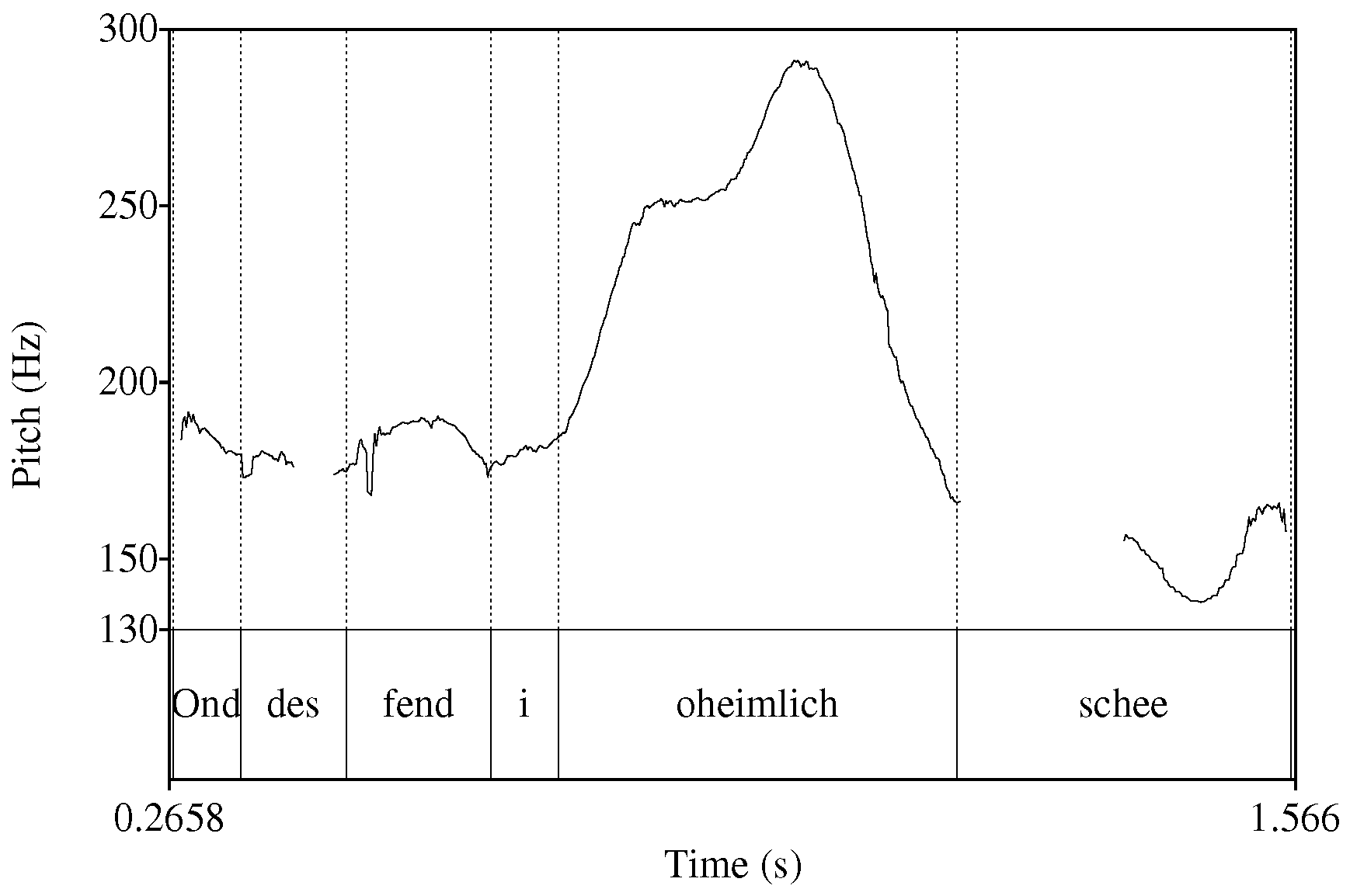

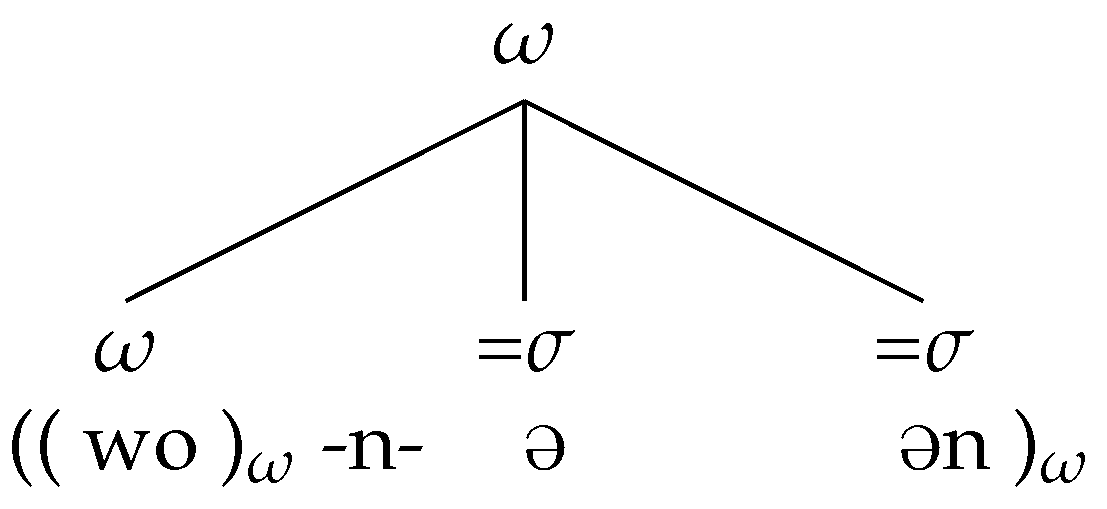
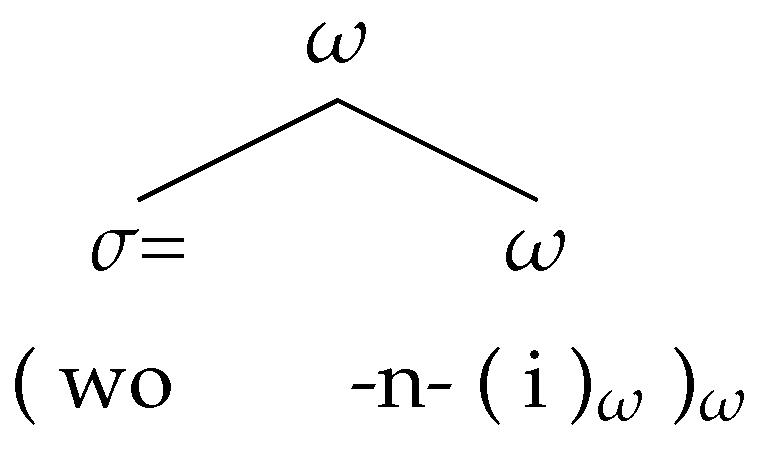

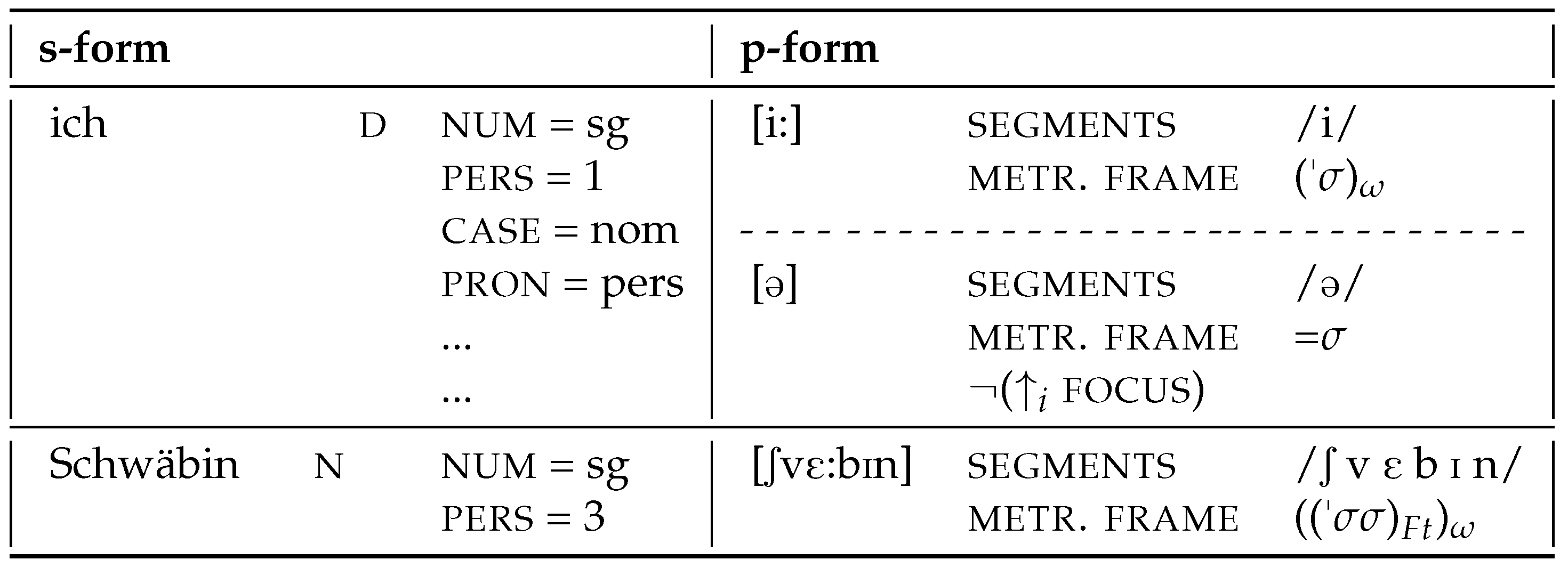
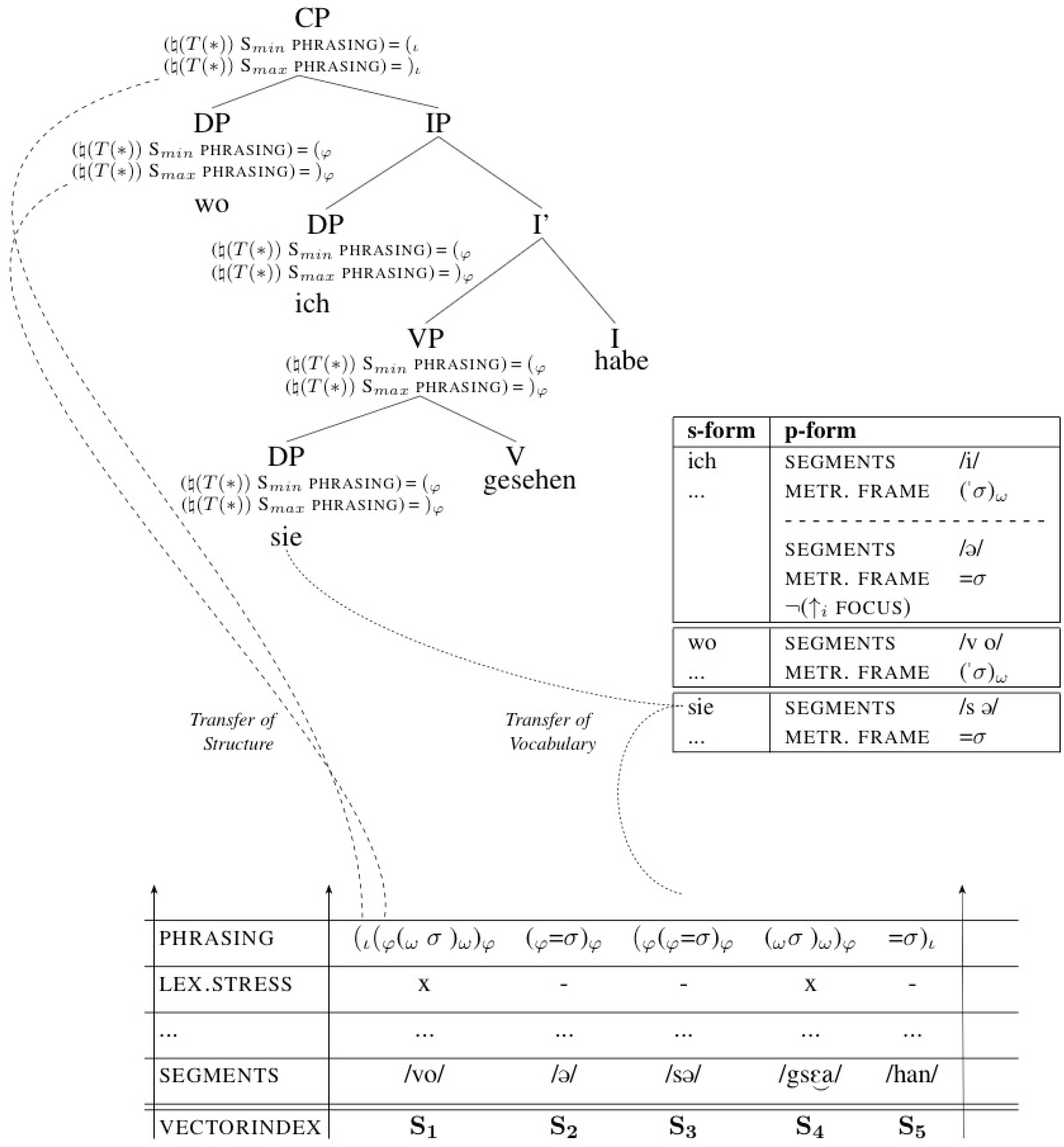
| Form | Initial | Medial | Final | Total |
|---|---|---|---|---|
| [i:] | 152 | 59 | 3 | 214 |
| [ə] | 0 | 86 | 2 | 88 |
| Total: | 302 |
| Form | Initial | Medial | Final | Total | |
|---|---|---|---|---|---|
| Prominent | Not Prominent | ||||
| [i:] | 74 | 64 | 17 | 1 | 156 |
| [ə] | — | 4 | 122 | 1 | 127 |
| 283 | |||||
| Description | Representation | |
|---|---|---|
| Input | (From Match constraints) | ((( wo)) (=ə) ((=sə) ( gs‿ea)) =han) |
| ∘ | (composed with) | ∘ |
| C1 | Remove small | (=) → = |
| Intermediate structure: | ((( wo)) =ə (=sə ( gs‿ea)) =han) | |
| ∘ | ∘ | |
| C2 | Recursive | () =+ → (() =+) |
| Intermediate structure: | (((( wo) =ə =sə)) ((( gs‿ea) =han))) | |
| ∘ | ∘ | |
| C3 | n-insertion | ((?*V) =(V?*)) → ((?*V) (-n-) =(V?*)) |
| Output | Final structure: | (((( wo) -n- =ə =sə)) ((( gs‿ea) =han))) |
Publisher’s Note: MDPI stays neutral with regard to jurisdictional claims in published maps and institutional affiliations. |
© 2021 by the author. Licensee MDPI, Basel, Switzerland. This article is an open access article distributed under the terms and conditions of the Creative Commons Attribution (CC BY) license (https://creativecommons.org/licenses/by/4.0/).
Share and Cite
Bögel, T. Function Words at the Interface: A Two-Tier Approach. Languages 2021, 6, 197. https://doi.org/10.3390/languages6040197
Bögel T. Function Words at the Interface: A Two-Tier Approach. Languages. 2021; 6(4):197. https://doi.org/10.3390/languages6040197
Chicago/Turabian StyleBögel, Tina. 2021. "Function Words at the Interface: A Two-Tier Approach" Languages 6, no. 4: 197. https://doi.org/10.3390/languages6040197
APA StyleBögel, T. (2021). Function Words at the Interface: A Two-Tier Approach. Languages, 6(4), 197. https://doi.org/10.3390/languages6040197






